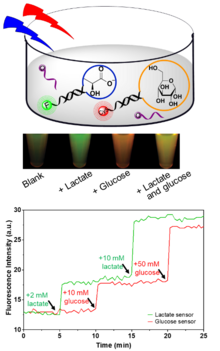Background
With limited oxygen, anaerobic glycolysis occurs to convert glucose to lactate. Athletes are keen to monitor lactate to stay in the aerobic metabolic state. A high level of lactate is also an indication of a variety of physiological and pathological conditions such as sepsis and heart attack, acidosis and cancer. More recently plasma lactate has been strongly associated with type 2 diabetes in older adults. The global serum lactate testing market is projected to grow at a CAGR of 7% reaching a value of $US 1.04 B by 2026.
Additionally, measurement of lactate is important in the food industry to monitor fermentation, bacterial contamination and wine production.
The detection of lactate has been traditionally carried out using enzymes namely lactate oxidase (LOx) and lactate dehydrogenase (LDH). LOx produces H2O2 as a co-product for indirect detection. LDH requires NAD+ as an electron acceptor. The reliability and sensitivity of such enzyme-based biosensors is affected by enzyme activity, denaturation, and the concentration of oxygen or NAD+, making calibration difficult.
Description of the invention
Aptamers are single-stranded nucleic acids and they have been shown to bind to a diverse range of target molecules. Unlike enzymes, aptamers rely solely on binding for target recognition and are independent of other reactants such as oxygen or NAD+. In this invention, an aptamer is produced to bind lactate with a dissociation constant of ~0.4 mM with excellent selectivity. Simultaneous detection of both lactate and glucose in a serum solution was achieved using the two sensors labeled with different fluorophores. The figure on the top left corner shows the diagram of the detection of both lactate and glucose in the same sample. The sensors had instantaneous responses. They can work even in 90% human blood serum.
Advantages
The aptamer-based technology can allow direct, rapid and continuous monitoring of lactate concentration. It is a totally different technology compared to the current enzyme-based assays. It will allow more robust, simpler and more cost-effective detection.
Potential applications
- Wearable biosensors for continuous lactate monitoring (athletes).
- Hospital emergency room (sepsis diagnosis).
- Bacterial infection diagnosis
- Lactate acidosis diagnosis
- Diabetes (Type 2) diagnosis and monitoring
- Food industry, fermentation, wine production.

Reference
10216
Patent status
US Provisional patent application 63/474,381
Stage of development
Lab prototype
Contact
Scott Inwood
Director of Commercialization
Waterloo Commercialization Office
519-888-4567, ext. 43728
sinwood@uwaterloo.ca
uwaterloo.ca/research